Reference no: EM131490420
Assignment
Question 1
Chlorophyll reflects (does not absorb) which color of light?
A) red
B) blue
C) violet
D) green
Question 2
The carbon source for organisms that derive their energy from photosynthesis is:
A) carbon monoxide
B) carbon dioxide
C) methane
D) hydrocarbons
E) glucose
Question 3
What is the enzyme that fixes carbon dioxide or oxygen in the light independent reactions?
A) carbon dioxide kinase
B) glucose 1-phosphocarbonase
C) Rubisco
D) catalase
Question 4
Plant cells that perform photosynthesis have the following organelles:
A) Golgi bodies
B) Chloroplasts
C) Mitochondria
D) Endoplasmic Reticula
E) all of these organelles
Question 5
The three reactions or stages of aerobic cellular respiration are:
A) glycolysis, calvin cycle and oxidative phosphorylation
B) fermentation, glycolysis and krebs cycle
C) Photosystems 1 and 2, calvin cycle and electron transport
D) glycolysis, krebs cycle and electron transport
Question 6
Which one of these ATP producing processes happens in the cytoplasm?
A) glycolysis
B) krebs cycle
C) citric acid cycle
D) electron transport
E) photosystem I,II
Question 7
Which ATP making process creates the most ATP?
A) fermentation
B) glycolysi
C) krebs cycle
D) electron transport
E) all produce equal amounts of ATP
Question 8
Which of the following happens to muscle cells in the absence of oxygen?
alcohol fermentation
glycolysis
krebs cycle
lactate fermentation
Question 9
Aerobic organisms use what as a final electron acceptor in the electron transport?
A) hydrogen
B) water
C) oxygen
D) carbon dioxide
Question 10
Unlike DNA, RNA contains:
A) adenine
B) uracil
C) phosphate groups
D) thymine
Question 11
Which of the following is an enzyme that builds DNA?
A) DNA polymerase
B) DNA helicase
C) DNA protienase
D) DNAase
Question 12
Which of the following are found in both DNA and RNA?
A) ribose, phosphate groups, and adenine
B) deoxyribose, phosphate groups, and guanine
C) phosphate groups, guanine, adenine and cytosine
D) phosphate groups, guanine, and thymine
Question 13
What type of bond holds the two strands of DNA together?
A) Covalent bonds
B) Atom bonds
C) Hydrogen bonds
D) Helicase bonds
Question 14
If you have the following template strand of DNA AATCCG, the correct complementary strand of DNA would be:
A) AATCCG
B) TTAGGC
C) TTAACC
D) TTACCG
E) GGCTTA
Question 15
Which of the following are the rules for base pairing in RNA?
A) Thymine must bond to uracil and guanine to cytosine
B) Adenine must bond to uracil and cytosine to guanine
C) Adenine must bond to thymine and guanine to cytosine
D) Thymine must bond to cytosine and guanine to adenine
Question 16
How many different types of RNA are there in protein synthesis?
A) 1
B) 20
C) 3
D) 100
Question 17
What happens during the process of translation?
A) Messenger RNA is made from DNA
B) The cell uses information from mRNA to make protein
C) Transfer RNA is made from messenger RNA
D) Copies of DNA molecules are made
Question 18
What happens during the process of transcription?
A) Messenger RNA is made from DNA
B) The cell uses information from mRNA to make protein
C) Transfer RNA is made from messenger RNA
D) Copies of DNA molecules are made
Which of the following is not true concerning the Phylum Porifera?
A) Reproduces asexually
B) Has spicules
C) Filter feeding
D) Three germ layers
Which of the following is not true concerning the Phylum Cnidaria?
A) Has three germ layers
B) Has one digestive opening
C) Has nematacysts
D) Has ability to move
Question 21
In the Phylum Platyhelminthes they have all of the following except:
Parasites
Heterotrophs
Flame Cells
Bilateral symmetry
coelom
Question 22
In the Phylum Arthropoda they can do all of the following except:
A) Reproduce asexually
B) Regenerate legs
C) Fly
D) Walk
E) Feed parasitically
Question 23
What two features do plants have that help them conserve water?
A) Waxy cuticle and stomata that open and close
B) Waxy stems that can close stomata
C) Guard cells and peptidoglycans
D) Oligolipids and wax sealers
Question 24
What is the difference between a monocot and a dicot?
A) Monocots have a single stems and dicots two
B) Monocots have a single cotyledon and dicots two
C) Monocots have two cotyledons and dicots one
D) Monocots have one main root growth and dicots two
Question 25
How do seedless vascular plants differ from moss?
A) There is no difference
B) Mosses do not have chlorophyll
C) Seedless vascular plants do not have chlorophyll
D) Mosses do not have veins
Question 26
An example of a medusa stage in the phylum Cnidaria is the:
A) Cnidocyte
B) sponge
C) jellyfish
D) turbellaria
Question 27
Which answer would be an example of the phylum Echinodermata?
A) earthworm
B) starfish
C) flatworm
D) zebrafish
Question 28
A common characteristic of Annelids would be:
A) dorsal nerve chord
B) flame cells
C) setae
D) spicules
Question 29
Which answer is an example of the phylum Nematoda?
A) tapeworm
B) roundworm
C) earthworm
D) bollworm
Question 30
The gametophyte is which stage of a plant?
A) diploid
B) haploid
C) mobile
D) sessile
Question 31
The sporophyte would be which stage of the plant?
A) diploid
B) haploid
C) mobile
D) sessile
Question 32
What is the difference between gymnosperms and angiosperms?
A) gynosperms produce flowers and angiosperms produce seeds
B) gynosperms produce seeds and angiosperms only flowers
C) gynosperms are monocots while angiosperms are dicots
D) gynosperms produce seeds and angiosperms produce both flowers and seeds
Question 33
What living organism gave rise to land plants?
A) cyanobacteria
B) algae
C) moss
D) lichens
Question 34
Plants take up carbon dioxide through the:
A) cuticle
B) stem
C) leaf surface
D) stomata
Question 35
The difference between Artificial Selection and Natural Selection is:
A) There is no difference
B) Natural Selection chooses the characteristics naturally and Artificial Selection is chosen by humans
C) One is a natural disaster the other is not
D) Natural Selection is natural and Artificial Selection is done by predation
Question 36
What are two ways that prokaryotes generate genetic diversity?
A) mitosis and meiosis
B) binary fission and meiosis
C) transformation and conjugation
D) crossing over and binary fission
Question 37
Which of the following is not a reason why it is difficult to define a prokaryotic species.
A) the morpholgy of prokaryotes is similar
B) biochemistry differs among different strains within the same species
C) transformation occurs between different species of bacteria
D) some prokaryotes cause disease
Question 38
Which of the following can not be part of a single celled Protistan?
A) DNA
B) RNA
C) Protein
D) tissue layers
Question 39
What is an adaptation that some prokaryotes use to deal with a harsh environment.
A) flagella
B) multicellucellar extremophiles
C) bacterial spores
D) become extremophiles
Question 40
An example of a symbiotic fungus that has this relationship with the root of a plant would be which of the following?
A) Zygomyces
B) Yeast
C) Mycorrhizae
D) Lichen
Question 41
A saprophytic fungus gets its nutrition by:
A) dead matter
B) eating living tissue
C) parasitism
D) symbiotically
Question 42
Fungi belong to the kingdom:
A) Plantae
B) Animalia
C) Monera
D) Fungi
Question 43
The name of the reproductive structure of a fungal organism is:
A) haustoria
B) mycelium
C) mushroom
D) hyphae
Question 44
An example of a disease caused by a protozoan would be:
A) tuberculosis
B) food poisoning
C) malaria
D) lyme disease
Question 45
The number of species on the earth ranges from:
A) 2-50 billion
B) 20-300 million
C) 2-50 million
D) 1-2 billion
Question 46
Which fungal structure is used for extracting nutrients from a host organism?
A) Haustorium
B) Hyphae
C) Mycelium
D) Isogamete
Question 47
Which of the answers is an example of a disease vector?
A) Lichen
B) Mosquito
C) Plasmodium
D) biphenyl
Question 48
An example of a disease caused by bacteria:
A) Lyme's disease
B) Creuzfeld Jacob disease
C) Malaria
D) corn smut
Question 49
The digestive enzymes of fungal organisms are placed:
A) internally
B) intracellular
C) endocellular
D) outside the cell or extracellular
Question 50
Basidiomycetes are known as:
A) bread mold
B) cup fungi
C) club fungi
D) yeast
Question 51
Ascomycetes are known as:
A) cup fungi
B) bread mold
C) club fungi
D) yeast
Question 52
Zygomycetes are known as:
A) cup fungi
B) bread mold
C) club fungi
D) yeast
Question 53
Fungal organisms have the most in common with what other kingdom of living organisms?
A) Protista
B) Animalia
C) Plantae
D) Bacteria
Question 54
A lichen is a symbiotic relationship between what two types of organisms?
A) algae and a fungus
B) protistan and a fungus
C) Plant and a fungus
D) a lichen is just symbiotic
Question 55
What are some features that all animals have in common?
A) photosynthesis
B) multicellular
C) asexual and sexual reproduction
D) single-celled and multicellular forms
Question 56
Which is the smallest unit of life that can exist as a separate entity?
A) Cell
B) Molecule
C) Organ
D) A population
E) An Ecosystem
Question 57
Water is an example of a(n)
A) Atom
B) Ion
C) Molecule
D) Mixture
E) Element
Question 58
The element carbon with a molecular weight of 12 has:
A) 6 protons, 6 neutrons and 6 electrons
B) 4 protons, 6 neutrons and 2 electrons
C) 12 protons 12 neutrons and 12 electrons
D) 6 protons, 6 neutrons and 12 electrons
Question 59
These are the "powerhouse" of the cell.
A) Golgi bodies
B) Ribosomes
C) Mitochondria
D) Central Vacuole
E) Endoplasmic Reticulum
Question 60
What cell organelle is found in plant cells but NOT in animal cells?
A) Mitochondria
B) Chloroplast
C) Cell Membrane
D) Golgi Bodies
Question 61
These are sometimes referred to as rough or smooth, depending on the structure.
A) Golgi bodies
B) Ribosomes
C) Mitochondria
D) Lysosomes
E) Endoplasmic Reticula
Question 62
What reproductive feature is common to all mammals?
A) placenta
B) mammary glands
C) embryonic birth
D) live birth
E) DNA
Question 63
The molecules used to provide the cell energy to do cellular "work" are:
A) Pigment Molecules
B) Unidentifiable Molecules
C) ATP Molecules
D) Carbohydrate Molecules
E) Lipid Molecules
Question 64
Enzymes are what type of molecule?
A) lipids
B) carbohydrates
C) nucleic acids
D) proteins
Question 65
Hormones communicate to the cell and are:
A) carbohydrates
B) nucleic acids
C) lipids
D) proteins
E) Both lipids and protein
Question 66
Which of the following would be considered an inferential statistic?
A) Mean
B) Range
C) T-test
D) Standard deviation
E) All of these are inferential statistics
Question 67
The type of lipid that most of the cell membrane is made of is:
A) triglycerides
B) neutral fats
C) phospholipids
D) cholesterol
Question 68
What kind of bond exists between two amino acids in a protein?
A) hydrogen bond
B) peptide bond
C) ionic bond
D) adhesive bond
Question 69
Carbon is capable of forming a bond with:
A) oxygen and hydrogen making hydrogen bonds
B) four other atoms
C) other carbons to make inorganic molecules
D) nitrogen to make carboxylic acids
E) hydrogen making double bonds
Question 70
When using the scientific method which is the first step in the process?
A) Testing
B) Hypothesis
C) Inference
D) Observation of the phenomenon
E) Conclusion
Question 71
An ionic bond forms when two:
A) neutral atoms form a bond
B) water molecules form a bond
C) like charged molecules form a bond
D) oxygen atoms form a bond
E) oppositely charged atoms form a bond
Question 72
Enzymes can be denatured by all of the choices except:
A) extreme pH solutions
B) extreme saline solutions
C) extreme temperature
D) room temperatures
Question 73
In simple diffusion molecules move:
A) from a lower concnentration to a higher concnentration
B) with the use of ATP
C) from a higher concnentration to a lower concentration
D) without direction regarding concentration
Question 74
Active transport is different from passive transport because:
A) Active requires energy
B) Passive requires energy
C) Active is the same as facilitated diffusion
D) A concentration gradient is used
Question 75
A monomer used to put DNA together would be:
A) glucose molecules
B) fatty acids
C) amino acids
D) nucleotides
Question 76
Alleles are:
A) Different forms of the same gene
B) Two different genes on the same chromosome that interact
C) Chromosome pairs
D) Different forms of phenotypes
E) Two different loci on the same chromosome
Question 77
A human genome has 46 chromosomes/autosomes and the sperm cell has:
A) 44
B) 46
C) 23
D) 38
Question 78
How many different gametes will the parent AABBDd make?
A) eight
B) two
C) four
D) six
Question 79
What term best describes you if you have two chromosomes with different alleles?
A) heterozygous dominant
B) homozygous recessive
C) homozygous dominant
D) heterozygous
Question 80
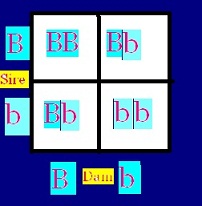
What genotypes are produced in the punnett square example?
A) 1 dominant, 2 heterozygous and 1 recessive
B) 1 heterozygote, 2 homozygous recessive and 1 homozygous dominant
C) 3 dominant and 1 recessive
D) 3 recessive and 1 dominant
Question 81
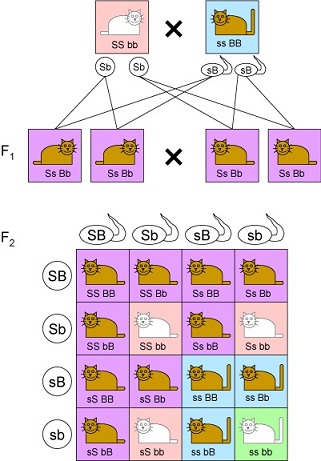
The punnett square has nine individuals with what phenotypes?
A) nine with the same genotype
B) nine with both dominant characterisitics
C) nine individuals with one recessive and one dominant phenotype
D) nine with both recessive characteristics.
Question 82
Which individual would have the largest number of autosomes?
A) A person with Klinefelter syndrome
B) A person with Turner syndrome
C) A healthy woman
D) A healthy man
E) A person with Down syndrome
Question 83
Which individual would have the largest number of sex chromosomes?
A) A person with Klinefelter syndrome
B) A person with Turner syndrome
C) A healthy woman
D) A healthy man
E) A person with Down syndrome
Question 84
If Albinism was a dominant X-sex-linked trait fathers having the trait would pass it to all of their:
A) Offspring regardless of gender
B) Male offspring
C) Albino offspring
D) Female offspring
Question 85
An example of incomplete dominance would be:
A) Eye color
B) AB blood type
C) Red and white flowers producing pink offspring
D) all of the answers are correct
Question 86
An example of codominance would be:
A) Eye color
B) AB blood type
C) Red and white flowers producing pink offspring
D) all of the answers are correct
Question 87
If a woman with blood type B had a child with blood type O you would expect the genotype of:
A) the father would only have blood type allele O
B) the mother would have the alleles B and O
C) the father would have the alleles A and B
D) The mother would have the alleles A and A
Question 88
A person with blood type AB had a father that had blood type B. What are the possible genotypes of that person's mother?
A) Every blood type.
B) The blood types A, B or AB.
C) Genotypes AO, AA and AB.
D) Genotypes BO, BB and AB.
Question 89
A population is represented by the equation p2+ 2pq + q2 and you need to know how many heterozygotes are in the population, which part of the equations represents them?
A) p2
B) 2pq
C) q2
D) none of the answers
Question 90
If the equation .25 + .5 + .25 were the numbers in the Hardy-Weinberg equation what is the frequency of heterozygotes?
A) 100,000
B) 25
C) 25%
D) 50%
Question 91
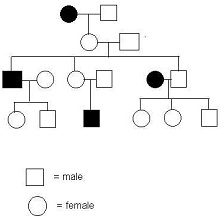
The trait of interest displayed in the pedigree above is more than likely:
A) sex-linked dominant
B) sex-linked recessive
C) autosomal dominant
D) autosomal recessive
Question 92
There are many genetically inherited diseases or conditions. When the allele, causing the condition, is recessive the parents can be carriers of the allele but they are unaffected by the disease themselves. The dominant allele protects them. However, there are conditions caused by dominant alleles. For example, the condition Achondroplasia, which causes dwarfism in humans, is the result of a dominant allele. Therefore only one allele is required to have Achondroplasia. Achondroplasia is lethal for those that are homozygous dominant and no adult exists with that genotype. Migraine headaches are another example of a dominant allele causing a deleterious condition. In cases like this at least one parent is affected by the condition if it is passed to the offspring. We will use A and a to represent the dominant and recessive alleles for Achondroplasia. In addition, M and m will be used for the dominant and recessive alleles for migraine headaches. Consider the following problem. A woman with Achondroplasia who has never had a migraine headache marries a man that has migraine headaches but does not have Achondroplasia. The man's father did not have migraine headaches. The woman's mother did not have Achondroplasia. Based upon the following information what is the genotype of the woman?
A) You cannot determine this from the information given.
B) The AAMm would be her genotype.
C) The Aamm would have to be her genotype.
D) The aaMM would have to be her genotype.
Question 93
There are many genetically inherited diseases or conditions. When the allele, causing the condition, is recessive the parents can be carriers of the allele but they are unaffected by the disease themselves. The dominant allele protects them. However, there are conditions caused by dominant alleles. For example, the condition Achondroplasia, which causes dwarfism in humans, is the result of a dominant allele. Therefore only one allele is required to have Achondroplasia. Achondroplasia is lethal for those that are homozygous dominant and no adult exists with that genotype. Migraine headaches are another example of a dominant allele causing a deleterious condition. In cases like this at least one parent is affected by the condition if it is passed to the offspring. We will use A and a to represent the dominant and recessive alleles for Achondroplasia. In addition, M and m will be used for the dominant and recessive alleles for migraine headaches. Consider the following problem. A woman with Achondroplasia who has never had a migraine headache marries a man that has migraine headaches but does not have Achondroplasia. The man's father did not have migraine headaches. The woman's mother did not have Achondroplasia. Based on the information above what is the genotype of the man?
A) You could not determine this from the information given.
B) The aaMm would have to be his genotype.
C) The AaMm would have to be his genotype.
D) The aaMM would have to be his genotype.
Question 94
Which stage of mitosis has DNA starting to condense into chromosomes?
A) Prophase
B) Metaphase
C) Anaphase
D) Telophase
Question 95
In which stage of mitosis do separate sets of chromosomes exist and begin migrating away from each other?
A) Prophase
B) Metaphase
C) Anaphase
D) Telophase
Question 96
After telophase is complete _____ will happen resulting in two daughter cells.
A) Anaphase
B) crossing over
C) cytokinesis
D) telokinesis
Question 97
Someone with Klinefelter's syndrome would have what different about their karyotype?
A) They would not be able to express a karyotype because they are sterile.
B) They would express a trisomy on chromosome 23.
C) They would have three chromosomes for each loci rather than two.
D) They would have a karyotype with a missing X sex chromosome.
Question 98
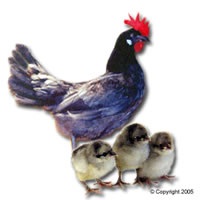
Andalusian chickens are an example of incomplete dominance. If you wanted to raise Andalusian Blue chickens, the way to produce the most would be:
A) to cross two Andalusian Blue chickens
B) to cross a homozygous black with a homozygous white
C) to cross two heterozygotes
D) to cross a white with a blue chicken
Question 99
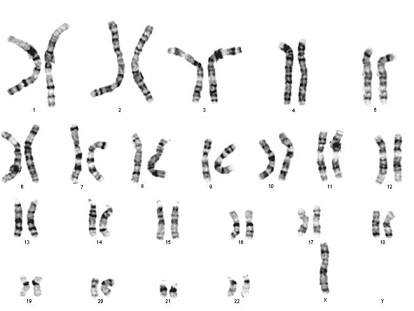
What syndrome is this karyotype displaying?
A) Turner's Syndrome
B) Klinefelter's Syndrome
C) Down Syndrome
D) Brown's Syndrome
Question 100
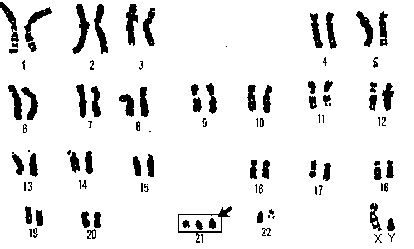
What syndrome is the karyotype displaying?
A) Turner's Syndrome
B) Klinefelter's Syndrome
C) Down Syndrome
D) Brown's Syndrome.